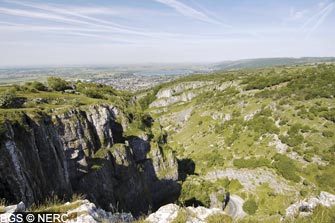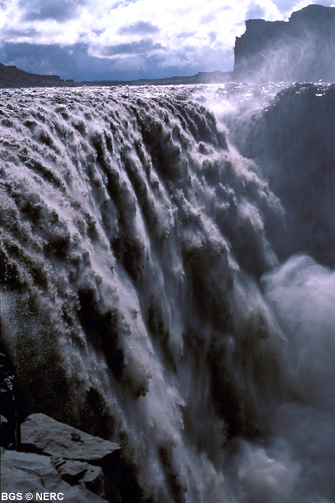
Dry valleys and gorges

The Mendip plateau is incised by numerous dry valleys which deepen into spectacular gorges such as Cheddar, Ebbor, and Burrington Combe, as the steep flanks of the hills are approached. The largest of these, Cheddar Gorge, is entrenched up to 120 m deep.
The origins of these dry valleys and gorges have been debated for over a century. The earliest ideas involved earthquake rifting and similar catastrophic phenomena. The first plausible hypothesis, that the gorges were formed by cavern collapse was put forward in 1862, a myth that is still often perpetuated in many modern geological texts. This theory remained popular until 1927 when it was suggested the gorges were cut by surface rivers.

Neither Cheddar or any of the other gorges and dry valleys are collapsed caverns, except possibly the Wookey Hole ravine. The size of the smallest gorge on Mendip is still far larger than even the largest Mendip caves such as GB Cave, and Lamb Leer. Many dry valleys have cut though existing cave passages. Furthermore, most stream caves on Mendip descend rapidly at first before levelling out at depth, whereas the steepest section of both Cheddar and Ebbor Gorge is near the mouth.
The Mendip dry valleys and gorges were incised over the last million years or so by meltwater rivers during the Ice Age, when the caves were blocked by ice, gravel and frozen mud. Although the area was never glaciated, the region was still deeply frozen much of the year. Torrents of summer meltwater from the snow caps poured off the hills. The material eroded during these periods was deposited as large alluvial fans (marked as 'head' on most geological maps) extending out from the gorge mouth, an excellent example occurs at Burrington Combe.
On western Mendip, many modern valleys follow earlier filled-in Triassic valleys where erosion has picked out the softer Mercia Mudstone, in preference to the harder, more resistant Carboniferous Limestone.
Apart from a few exceptions in the extreme east, all the valleys cut into the limestone are now dry. This is due to the development of underground drainage and the formation of extensive cave systems.
- Home
- Overview maps
- Locality
areas
- Cheddar Gorge
- Charterhouse
- Blackdown
- Burrington Combe
- Shipham & Rowberrow
- Crook Peak & Axbridge
- Banwell to Churchill
- Priddy
- Harptree & Smitham Hill
- Draycott & Westbury-sub-Mendip
- Wookey Hole & Ebbor Gorge
- Wells
- Great Elm & Vallis Vale
- Mells & the Wadbury Valley
- The Vobster area
- The Whatley area
- Torr Works & Asham Wood
- Beacon Hill
- Stoke St Michael & Oakhill
- Holwell & Nunney
- Shepton Mallet & Maesbury
- Gurney Slade & Emborough
- The Nettlebridge valley
- Geology
- Minerals and mines
- Quarrying
- Caves and karst
- Biodiversity
- Detailed site information
- Acknowledgements
- External links
- Search
- Site map